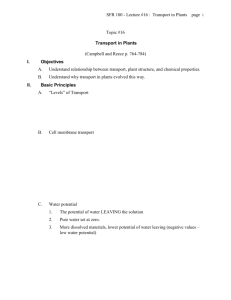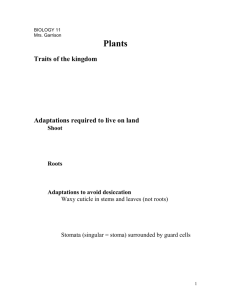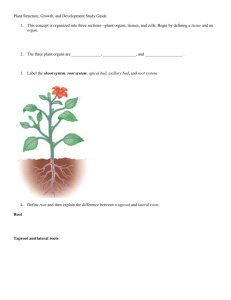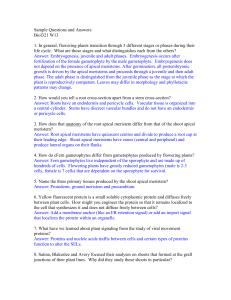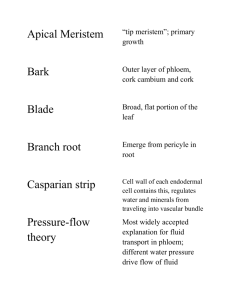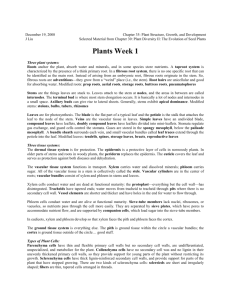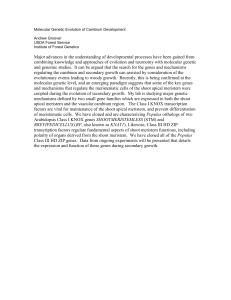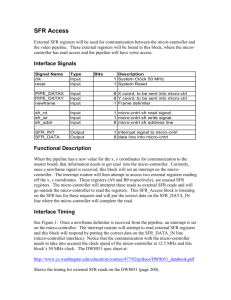Topic 15: Plant Structure and Growth
advertisement
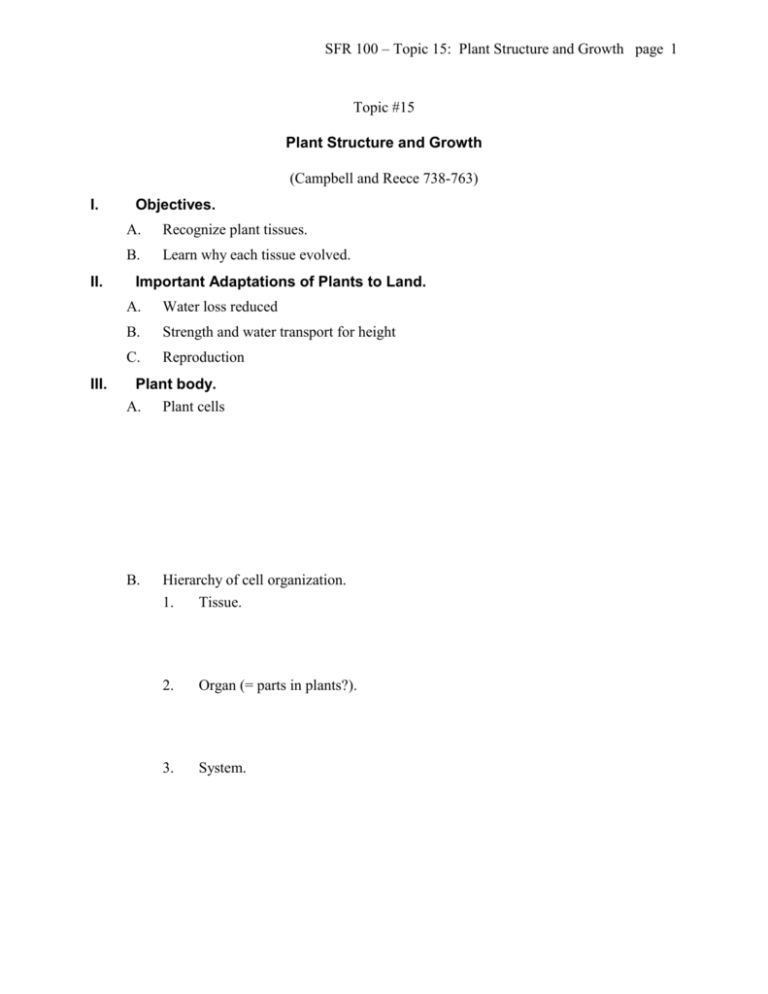
SFR 100 – Topic 15: Plant Structure and Growth page 1 Topic #15 Plant Structure and Growth (Campbell and Reece 738-763) I. II. III. Objectives. A. Recognize plant tissues. B. Learn why each tissue evolved. Important Adaptations of Plants to Land. A. Water loss reduced B. Strength and water transport for height C. Reproduction Plant body. A. Plant cells B. Hierarchy of cell organization. 1. Tissue. 2. Organ (= parts in plants?). 3. System. SFR 100 – Topic 15: Plant Structure and Growth page 2 C. IV. Basic parts (organs) 1. Roots 2. Stem 3. Leaves 4. Flowers Plants have indeterminate growth A. Continue to increase in size as conditions permit B. Meristems are the source of new cells for indeterminate growth 1. Apical meristems 2. Lateral meristems SFR 100 – Topic 15: Plant Structure and Growth page 3 C. V. VI. Cells must stop dividing when conditions are not favorable for growth, such as in winter Two major groups of flowering plants A. Monocots - B. Dicots - C. Tissue development differs between these groups. Plant tissues and systems - Cell Types. A. All of these tissues arise from the apical meristems B. Ground tissues - found in almost all tissue systems 1. 2. Parenchyma. a) Cell structure. b) Functions. Collenchyma. a) Cell structure. b) Functions. SFR 100 – Topic 15: Plant Structure and Growth page 4 3. Sclerenchyma. a) Cell structure. b) C. Functions. Vascular tissue. 1. Xylem - cell types and functions. a) Functions b) Tracheids. c) Vessel elements. d) Parenchyma. e) Sclerenchyma (fibers). SFR 100 – Topic 15: Plant Structure and Growth page 5 2. D. VII. Phloem - cell types and functions. a) Function b) Sieve elements. c) Companion cells. d) e) Parenchyma. Sclerenchyma. Surface or dermal tissue. 1. Epidermis - 2. Cuticle - Plant tissues and systems - Primary Growth. A. Roots. 1. Function 2. Fibrous vs. taproot system. 3. Root cap SFR 100 – Topic 15: Plant Structure and Growth page 6 4. Apical meristem 5. Zone of cell division - 6. Zone of elongation - 7. Zone of maturation - 8. Epidermis 9. Stele 10. Endodermis 11. Cortex SFR 100 – Topic 15: Plant Structure and Growth page 7 B. Stems. 1. Function 2. Buds and nodes a) Growing tip - location of apical meristem b) Terminal bud c) Nodes - "Junctions" on stem d) Internodes – e) Axillary buds SFR 100 – Topic 15: Plant Structure and Growth page 8 f) C. Apical dominance 3. Epidermis 4. Vascular bundles 5. Ground tissue Leaves 1. Function 2. Blade - 3. Petiole - SFR 100 – Topic 15: Plant Structure and Growth page 9 4. VIII. Epidermis a) Single layer of cells b) Stomata - openings of on bottom of leaf c) Guard cells - regulate the size of the stomata 5. Mesophyll 6. Vascular tissue Plant tissues and systems - Secondary Growth. 1. New tissues are continually needed SFR 100 – Topic 15: Plant Structure and Growth page 10 2. Vascular cambium 3. Vascular tissue a) Xylem and ray cells form on inside of vascular cambium (i) Early wood (ii) Late wood (iii) Sapwood - (iv) Heartwood - b) Phloem c) Rays SFR 100 – Topic 15: Plant Structure and Growth page 11 4. Periderm a) b) 5. IX. Combination of cork cambium and cork cells (i) Cork cambium (ii) Cork cells As diameter increases, periderm keeps arising within the outer layers of the functioning phloem. Bark a) Inner bark - b) Outer bark: c) Lenticels Dicots vs. Monocots A. Roots B. Stems SFR 100 – Topic 15: Plant Structure and Growth page 12 C. Leaves D. Flowers X. Key Terms. cell wall secondary cell wall middle lamella tissue organ system root shoot leaf meristematic tissue indeterminate growth apical meristem primary tissue lateral meristem secondary tissue Dormancy Monocots Dicots ground tissue parenchyma collenchyma sclerenchyma fiber sclereid epidermis cuticle vascular tissue xylem tracheid vessel element border pits phloem sieve element companion cells fibrous roots taproot root cap Zone of cell division protoderm procambium ground meristems Zone of elongation zone of maturation root hairs stele pericycle endodermis cortex terminal bud leaf primordial nodes axillary buds apical dominance vascular bundles pith blade petiole stomata guard cells mesophyll palisade layer spongy layer vascular cambium early wood late wood sapwood heartwood rays periderm cork cambium cork cells bark inner bark outer park lenticels

